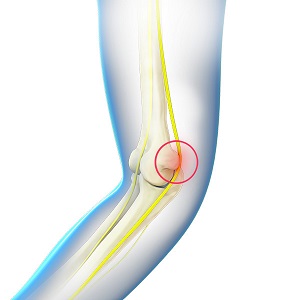
Ulnar nerve neuropathy is the entrapment or compression of the ulnar nerve causing impairment of its function.
The branches from the spinal nerve C8 (cervical) and T1 (upper thoracic) give rise to the ulnar nerve that passes close to the ulna bone of the forearm. The ulnar nerve is one of the three major nerves of the hand that supply the hand muscles and cause their contraction. It provides sensation to the hand, little finger, and half of the ring finger.
Funny Bone: At the elbow region, near the epicondyle of the humerus (the bony bump at the lateral side), the ulnar nerve is close to the skin with very little soft tissue to protect or cover it. This region is commonly referred to as the ‘funny bone’ as hitting this area causes a sudden feeling of shock.
Causes
Factors that cause the entrapment or compression of the ulnar nerve include:
- Thickening of the ligaments at the ‘funny bone’ region
- Muscle thickness causing nerve compression
- Trauma causing a bone fracture, nerve compression, and damage
Symptoms
The symptoms of ulnar nerve neuropathy include:
- Feeling of pain and a tingling sensation in the ring finger and little finger
- Weakening of the hand muscles due to loss of nerve function
- Losing the ability to grip objects and wasting of the muscles (at later stages)
Diagnosis
Your doctor will assess your symptoms and take your medical history. Specific movements may be performed to physically examine your muscle strength. Gentle tapping at the funny bone region may be performed to observe if you feel sharp sensations in your ring finger and little finger. Imaging studies (X-ray, MRI, CT-scan) may be ordered. Nerve tests including electromyography and nerve conduction studies may be ordered to confirm the diagnosis.
Treatment
The treatment depends on the severity of the disorder. Your treatment plan may include:
- A combination of non-steroidal anti-inflammatory drugs (NSAIDs) and opioids to manage pain.
- Your forearm will be supported with a brace and you will be encouraged to rest the arm for a certain period.
- You will not be allowed to lift heavy objects or perform any strenuous activity for a few weeks.
- Physical therapy exercises will be taught to enhance your flexibility, range of motion and strength.
Surgery may be required if you do not respond to conservative treatment options. Ulnar nerve transposition is performed that involves moving the ulnar nerve to an appropriate position from the back of the medial epicondyle. In some cases, a part of the medial epicondyle may be cut to ensure the free movement of the ulnar nerve.
